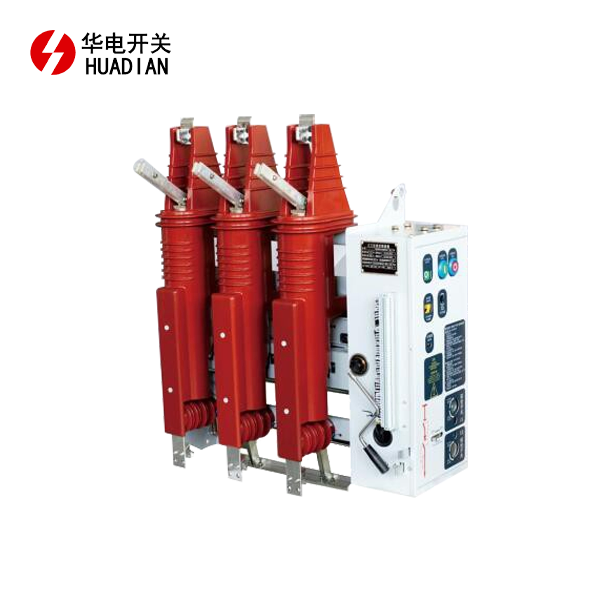
What is a Three-Station Vacuum Circuit Breaker?
2025-10-29 11:38:32
A three-position circuit breaker is a composite high-voltage switchgear that integrates isolation, grounding, and circuit connection/disconnection functions into a single device. Essentially, it combines the functions of a circuit breaker and a three-position disconnector.

Detailed Overview
1. Core Concept: What is "Three-Position"?
"Three-Position" refers to the device's three defined, interlocked operating positions:
Closed (On) Position: The main circuit is connected, the circuit breaker contacts are closed, and power can flow normally. In this position, it functions as a normal circuit breaker, connecting and disconnecting load current and fault current.
Open (Isolated) Position: The main circuit is disconnected, the circuit breaker contacts are separated, and a clear, visible insulation break is formed. This position ensures isolation of the device from live lines, providing safe conditions for maintenance.
Grounded Position: The device reliably connects one side of the line (usually the downstream side requiring maintenance) to the ground. This position discharges residual charge on the line and prevents accidental power supply, ensuring the safety of maintenance personnel.
These three positions are mechanically interlocked to prevent accidental operation. For example, it is impossible to switch directly from the closed position to the grounded position, thus preventing short-circuit accidents.
2. Key Features and Advantages
Integration and Compactness: Combining the functions of a circuit breaker, disconnector, and earthing switch into one unit significantly reduces substation installation space. This is particularly common in GIS (gas-insulated metal-enclosed switchgear) and gas-filled ring main units.
High Reliability: Mechanical interlocking fundamentally eliminates the possibility of misoperation, providing exceptional safety.
Easy Operation: All operations can typically be completed sequentially using a single operating mechanism (electric or manual), providing a clear workflow.
Easy Maintenance: The compact design and reduced number of components reduce maintenance workload.
3. Operating Principle and Operation Sequence
The operation of a three-position circuit breaker follows a strict logical sequence, typically achieved through its associated operating mechanism (such as a spring-operated mechanism).
Standard Safety Operating Procedure:
Transitioning from Operation to Maintenance:
Step 1 (Opening): Open the circuit breaker from the closed position and switch it to the open (isolating) position. This disconnects the circuit.
Step 2 (Verifying No Power): Verify that there is no voltage on the line side using a meter or indicating device.
Step 3 (Grounding): Switch the circuit breaker from the open position to the grounded position. This ensures that the line side is reliably grounded.
Transitioning from Maintenance to Operation:
Step 1 (Removing Grounding): Switch the circuit breaker from the grounded position back to the open (isolating) position.
Step 2 (Closing): Switch the circuit breaker from the open position to the closed position to restore power.
4. Comparison with conventional circuit breaker + disconnector solution
| Features | Three-position circuit breaker |
The traditional "circuit breaker + independent disconnector" solution |
|---|---|---|
| Structure | Integrated design, compact structure |
Decentralized design, occupies a large space |
| Function | Combined connection, disconnection, isolation, and grounding |
Functions are shared among different devices |
| Interlocking | Built-in mechanical interlock for absolute reliability |
Requires additional mechanical or electrical interlocking devices |
| Application | Primarily used in compact equipment such as GIS and inflatable cabinets |
Widely used in traditional substations such as AIS (air-insulated substations) |
| Cost | The device itself may be more expensive, but it saves overall space and installation costs | Equipment costs may be lower, but the overall footprint and installation complexity are increased. |
5. Main Application Scenarios
Three-position circuit breakers are key equipment in modern medium- and high-voltage power distribution systems and are particularly suitable for:
Gas-Insulated Switchgear (GIS)
Pneumatic Ring Main Unit (SF6 or environmentally friendly gas)
Prefabricated Substations (Prefabricated Substations)
Industrial, commercial, and urban power distribution networks requiring high reliability and space conservation
Summary
The three-position circuit breaker is an outstanding example of integrated modern switchgear technology. By seamlessly integrating the three crucial functions of connection, isolation, and grounding within a single unit, coupled with reliable mechanical interlocking, it significantly enhances equipment safety, reliability, and space efficiency. It has become a mainstream choice for medium- and high-voltage applications, particularly for compact switchgear.
Shaanxi Huadian - the quality benchmark in the field of vacuum circuit breakers, we look forward to contacting you:pannie@hdswitchgear.com.
YOU MAY LIKE



